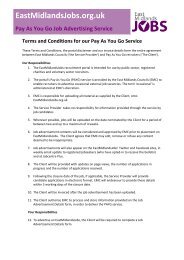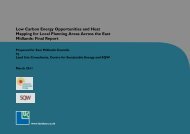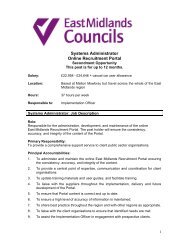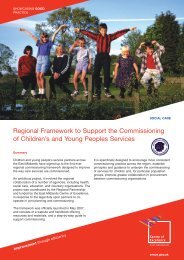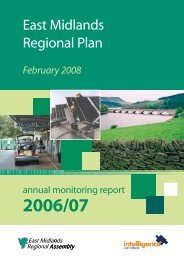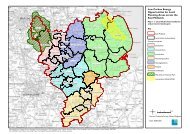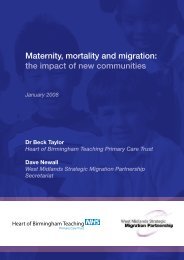East Midlands Regional Spatial Strategy 2005/06
East Midlands Regional Spatial Strategy 2005/06
East Midlands Regional Spatial Strategy 2005/06
Create successful ePaper yourself
Turn your PDF publications into a flip-book with our unique Google optimized e-Paper software.
<strong>East</strong> <strong>Midlands</strong> <strong>Regional</strong> <strong>Spatial</strong> <strong>Strategy</strong> Annual Monitoring Report <strong>2005</strong>/<strong>06</strong><br />
in the monitoring of this policy. Strategic<br />
Environmental Assessment, which meets the<br />
requirements of the EU Directive, was introduced<br />
during 2004 and provides the opportunity to ensure<br />
that the impacts of plans and programmes on the<br />
historic environment are made explicit.<br />
5.44 The annual Heritage Counts reports on the<br />
state of the historic environment, which are<br />
published every November and include a regional as<br />
well as a national report and data, are available on<br />
www.heritagecounts.org.uk or via the HELM portal<br />
www.helm.org.uk .<br />
5.45 The effect of development on the historic<br />
environment may result in loss or change in historic<br />
townscape and landscape character, e.g. as a result of<br />
town centre redevelopment. Some changes may<br />
enhance historic character or the setting of historic<br />
assets.There are tools, based upon characterisation,<br />
which can ensure that the historic environment is<br />
fully taken into account in areas of change, e.g. as<br />
part of masterplanning. Boston has undertaken a<br />
baseline urban character study of its town centre to<br />
guide change and Lincoln City undertook an ‘Inquiry<br />
by Design’ in October <strong>2005</strong>, to shape the<br />
development of a masterplan for its historic centre.<br />
5.46 Conservation-led regeneration can ensure that<br />
local character and sense of place is maintained and<br />
enhanced. Heritage area-based grant funding on a<br />
partnership basis continued during the year. Heritage<br />
Economic Regeneration Schemes (HERS) were<br />
launched in 1999 by English Heritage. In <strong>2005</strong>/6 over<br />
40 schemes were running across the Region. In<br />
addition, the Heritage Lottery Fund (HLF) was<br />
supporting a number of Townscape Heritage<br />
Initiative schemes, such as at Belper in the Derwent<br />
Valley Mills World Heritage Site.<br />
5.47 Good schemes that retain the historic character<br />
of buildings and find new uses for them continue to<br />
come forward.The continued use as a museum of<br />
Newarke Houses in Leicester, a Grade II* listed<br />
building in the heart of the Old Town, was facilitated<br />
by funding from the HLF.The scheme included the<br />
provision of a lift.Willoughby House in Nottingham, a<br />
Grade II* listed Georgian town house, had functioned<br />
as offices for almost 100 years but was in need of a<br />
new single use. Its conversion to a flagship store for<br />
Paul Smith required a flexible approach to shop<br />
fittings by the architect and designers, which placed<br />
an emphasis on retaining the historic character of the<br />
building as an integral part of the shopping<br />
experience.<br />
Policy 32: <strong>Regional</strong> Priorities for Sports and<br />
Recreational Facilities<br />
Local Authorities should work with County based<br />
Sport Partnerships, the <strong>East</strong> <strong>Midlands</strong> <strong>Regional</strong><br />
Sports Board, Sport England and other relevant<br />
bodies to ensure that there is adequate provision<br />
of sports and recreational facilities<br />
Target:<br />
• Targets set in the <strong>Regional</strong> Sports <strong>Strategy</strong><br />
Indicator:<br />
• Number of new sports and recreational facilities<br />
provided per population served<br />
Results:<br />
• No data was available for <strong>2005</strong>/<strong>06</strong> as was the case in<br />
2004/05<br />
Data Analysis<br />
5.48 As in the previous monitoring report no<br />
progress in collecting data for this policy has been<br />
made due to difficulties such as definitions of sports<br />
and recreation facilities and difficulty when<br />
considering the size of facilities e.g. one large facility<br />
may be better than several smaller ones.<br />
Policy Commentary<br />
5.49 The <strong>East</strong> <strong>Midlands</strong> now has five established<br />
County Sports partnerships to co-ordinate a strategic<br />
approach to the development of sport and facility<br />
development at county level. Monitoring of sport by<br />
Sport England now covers three areas; participation -<br />
the numbers of people taking part in sport;<br />
frequency - how often do people take part in activity<br />
and access and use of quality facilities.These have<br />
been developed into Comprehensive Performance<br />
Assessment Indicators (CPA). These surveys were due<br />
to establish baseline positions in <strong>2005</strong> and then<br />
repeated at regular, although different, intervals after<br />
that.<br />
86




